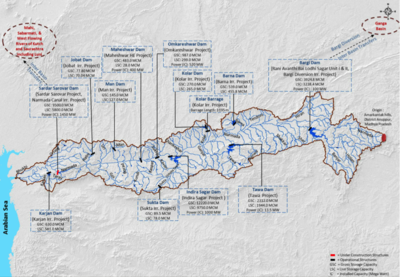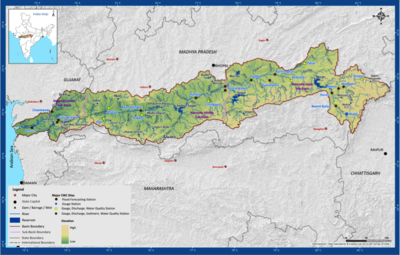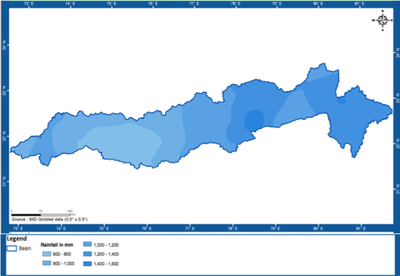Conflicts over development in India's Narmada River Basin
| Geolocation: | 22° 24' 44.2148", 71° 3' 52.6813" |
|---|---|
| Total Population | 16.216,200,000 millionmillion |
| Total Area | 98,79698,796 km² 38,145.136 mi² km2 |
| Climate Descriptors | Semi-arid/steppe (Köppen B-type), Arid/desert (Köppen B-type), Monsoon, temperate |
| Predominent Land Use Descriptors | agricultural- cropland and pasture, conservation lands, industrial use, forest land, religious/cultural sites |
| Important Uses of Water | Agriculture or Irrigation, Domestic/Urban Supply, Hydropower Generation, Industry - consumptive use, Livestock |
| Water Features: | Narmada River, Narmada River Basin |
| Riparians: | India, Indigenous Population, Gujarat, India, Maharashtra, India, Madhya Pradesh, India |
| Water Projects: | Sardar Sarovar Dam |
| Agreements: | Narmada Water Disputes Tribunal Award, Interstate River Water Disputes Act |
Contents
Summary
The Narmada River is the fifth longest river in the Indian subcontinent, and one of the five holy rivers of India. Plans to develop the river for irrigation and hydropower have been discussed for over a century. It was only after India’s independence from Great Britain in 1947 that plans began to take shape, thanks to Prime Minister Jawaharlal Nehru’s aggressive development agenda. Flowing 1,312 kilometers through three states in Central and Western India, Gujarat, Maharastrha, and Madhya Pradesh, the Narmada basin now boasts over 3000 dams, a “giant staircase of reservoirs.” The largest of these dams, the Sardar Sarovar, also boasts of causing a protracted conflict starting shortly after Indian independence and continuing through the present day, involving countless government agencies, decades of negotiations between four states, one of the largest people’s mobilizations in India’s history, pressure from international environmental organizations and governments, the World Bank, multiple supreme court cases, and tens (or by some counts, hundreds) of thousands of people displaced. As of May 2014, the construction of the dam is still not complete, so this list of actors could potentially grow.
The conflict began as an interstate issue over the right of the state of Gujarat to raise the height of a dam on its portion of the Narmada River, creating a submergence area that would impact plans for hydropower development in co-riparian states Madhya Pradesh and Maharashtra. The central government of India intervened, establishing the Narmada Water Disputes Tribunal, which allocated shares of water and power from the dam between the three states and an extremely arid non-riparian state, Rajasthan, according to estimates of river flows and hydropower potential based on its own study. The Tribunal’s award also established minimum requirements for rehabilitation and resettlement of “Project-Affected Persons,” based on its study’s estimates of the dam’s submergence area and the number of land-owning families living in those areas. This initial, binding decision was made by a three-judge panel, and did not involve participation by representatives of the four states involved, nor did it include any efforts to consult with communities whose villages would be submerged, over half of which were Adivasis (indigenous Indians) who are subject to special protections in the Indian constitution.
In the mid 1980s, when the World Bank agreed to finance the project before an environmental impact assessment was conducted, communities scheduled to be submerged by the dam construction organized themselves into the Narmada Bachao Andolan (NBA), a coalition of farmers, Adivasis, and activists. The NBA successfully mobilized the interest of international environmental organizations, which prompted the World Bank to conduct an independent review of the project and eventually withdraw based on issues surrounding environmental impacts and inadequate resettlement and rehabilitation. The project has continued to this day, financed by the Indian central government and individual states, and the NBA continues to be active in national politics and advocate for just compensation.
Natural, Historic, Economic, Regional, and Political Framework
History
Timeline of Narmada River Development
| Date | Event Description |
|---|---|
| 1901 | First Indian Irrigation Commission proposes construction of a dam on the Narmada River. |
| 1947 | Independence from Great Britain.
Investigations begin into Narmada’s potential for irrigation and hydropower by the Central Waterways, Irrigation and Navigation Commission, which recommends several sites in Gujarat. |
| 1956 | Commission selects a site near village Gora in Gujarat for Broach Project on Narmada River.
Anticipating interstate water disputes because of changing state borders, Parliament passes the Interstate River Water Dispute Act (Article 262 of the constitution), which provides a role for the central government in adjudicating conflicts surrounding interstate rivers. Elaborates dispute resolution process, involving forming an interstate tribunal. |
| 1960 | Bifurcation of Bombay state along linguistic lines into states of Gujarat and Maharashtra. |
| 1961 | Government of Gujarat gives approval for Narmada Valley Project. The project includes plans for 3,165 small, medium, and large dams. Prime Minister Jawalarl Nehru lays foundation stone for the project. |
| 1963 | Gujarat plans to raise the height of the largest planned dam at Navagam village to maximize storage benefits and extend irrigation to drought-prone areas near the Arabian sea coast, at the cost of submergence of potential planned hydropower sites in Maharashtra and Madhya Pradesh. Dispute arises between the states over water and power sharing. |
| 1964 | Indian central government appoints a high level committee to resolve dispute, which prepares a basin master plan involving the construction of 12 major projects in Madhya Pradesh and the Navagam dam in Gujarat. Gujarat endorses proposal, but Maharashtra refuses to support it. |
| 1969 | After negotiations fail to resolve dispute, the Narmada Water Disputes Tribunal (NWDT) is formed, according to the IRWD. |
| 1976 | Prime Minister Indira Gandhi adds article 48A to the constitution: “The State shall endeavour to protect and improve the environment and to safeguard the forests and wildlife of the country.” |
| 1979 | Narmada Water Disputes Tribunal gives its award, considering development of water resources as a whole, allocating shares of water and hydropower from the Sardar Sarovar dam project (renamed from Navagam dam). Partial share of the water allocated to a nonriparian state, Rajasthan. Award also determines usable flow of the river to be 27,000,000 acre feet (33 km3). Cost sharing formula, rehabilitation and resettlement package with costs borne by Gujarat, and regulated release requirement by Madhya Pradesh also included. |
| 1980 | Narmada Control Authority (NCA) established to manage award of the NWDT.
Prime Minister Indira Gandhi issues a directive mandating environmental impact assessments by federal agencies for medium and major irrigation projects, including dams. Indian Parliament passes the Forest Conservation Act and creates the Federal Department of the Environment. |
| 1985 | Federal Department of Environment upgraded to the Ministry of environment and Forests.
World Bank approves $450 million loan to India for Sardar Sarovar. Residents affected by the dam organize protest movement. Narmada Valley Development Authority (NVDA) set up for construction of Narmada projects in Madhya Pradesh. |
| 1986 | Parliament enacts Environmental Protection Act. |
| 1987 | Construction begins on Sardar Sarovar dam. |
| 1988 | Gujarat state government creates public company Sardar Sarovar Narmada Nigam (SSNL) to operate the dam. |
| 1991 | NCA releases submergence schedule for each of the three states, corresponding to different heights of dam during construction.
World Bank announces it will institute an Independent Review of the Sardar Sarovar Projects, unprecedented in its history. |
| 1992 | Independent Review, the “Morse Report,” published. Criticizes resettlement and rehabilitation process, inadequacy of environmental impact assessment. Recommends World Bank “step back from the projects and consider them afresh.”
World Bank continues to fund project, asks Indian to meet basic conditions within 6 months. |
| 1993 | Indian government asks World Bank to withdraw funding. Citing project irregularities, World Bank withdraws from Sardar Sarovar. |
| 1994 | The Narmada Bachao Andolan, a coalition of people’s movements in areas scheduled to be submerged, files a civil writ petition in the Supreme Court of India, questioning the basis of the Sardar Sarovar Dam and seeking a stay on the construction. |
| 1995 | India’s Supreme Court suspends construction of the dam, on grounds that the rehabilitation of displaced people had not been adequate. |
| 1999 | Governments of Gujarat, Madhya Pradesh, and Maharashtra set up a Grievance Redressal Authority (GRA). |
| 2000 | Supreme Court allows building construction to continue up to 90 meters (295 ft.). Additional construction to the dam’s planned height of 138 meters (453 ft.) requires approval by the NCA in five-meter (16 ft.) increments. |
| 2002 | Narmada Bachao Andolan protest movement reports est. 30,000 families not resettled.
NCA gives permission to raise height of dam from 90 to 95 meters. |
| 2003 | NCA gives permission to raise height of dam from 95 to 100 meters. |
| 2004 | NCA gives permission to raise height of dam from 100 to 110.64 meters. |
| 2006 | NCA gives permission to raise height of dam from 110.64 to 121.92 meters. |
| 2011 | NCA gives permission to raise height of dam from 121.92 to the full 138.64 meters, but Gujarat is blocked from continuing construction because of 400 Project-Affected families in Maharashtra. |
| 2013 | Maharashtra and Madhya Pradesh declare rehabilitation and resettlement complete in their states. All four states agree to recommend to NCA that construction continue to 138.64 meters. |
| 2014 | Planning begins for the Statue of Unity, a 182-meter (nearly 600ft) monument that will directly face the Sardar Sarovar dam. |
Ecological and Geographical Background
Map 1. Location of the Narmada Basin
Map 2. Major Water Resource Projects in the Narmada Basin
Map 3. Narmada Basin and Sub-basin Drainage, incl. Reservoirs (submergence areas)
Map 4. Narmada Basin Annual Average Rainfall
Governmental, Political, and Legal Context
The trajectory of the development of the Narmada Basin has its roots in rhetoric and legal frameworks established in the immediate period after India’s independence from Great Britain. India’s first Prime Minister Jawaharlal Nehru’s aggressive development agenda of modernization equated dam building with nation building, and was famously quoted as referring to dams as “the temples of modern India.” Traditional, small-scale irrigation systems were destroyed in favor of massive projects, over 3000 of which have been constructed in the 60+ years since independence.
The legal foundations of the development plans of the Narmada are based on a 1956 constitutional amendment, the Interstate River Water Dispute Act (IRWD). Anticipating interstate water disputes because of frequently changing state borders in the post-independence period, the law elaborates a dispute resolution process, involving forming a tribunal comprised of judges appointed by the Chief Justice of the Supreme Court. The bifurcation of Bombay state along linguistic lines into the states of Gujarat and Maharashtra—whose new borders were separated by the Narmada River—at the same time that Gujarat began planning major projects in the Narmada Basin, initiative just this sort of conflict when the states of Maharashtra and Madhya Pradesh realized that Gujarat’s plans for the Sardar Sarovar dam would submerge areas in which those two states were planning to develop hydropower projects. After failed negotiations between the states, the central government intervened and formed the Narmada Water Disputes Tribunal (NWDT), according to the IRWD. The allocations of water and shares of power determined by the award in 1979 (see Table 2), based on estimates of river flows by the Tribunal, are legally binding. Partial shares of the water are given to an extremely arid non-riparian state, Rajasthan. The Tribunal also establishes the Narmada Control Authority, with representatives of each state to manage the requirements of the Tribunal’s award.
Several environmental protection efforts followed the Tribunal’s award, including a law requiring environmental impact assessments of medium and major irrigation projects, including dams. The Ministry of Environment and Forests is also created at this time, which initiated an environmental impact assessment after the World Bank approved a $450 million loan to India to construct the Sardar Sarovar dam. Despite going against both India’s and the World Bank’s own policies regarding measuring environmental and social impacts of projects of this kind, dam construction begins in 1987.
Cases involving disputes over the Sardar Sarovar have been heard twice by the Supreme Court, the first of which was brought in 1995 by the Narmada Bachao Andolan, a coalition of protest movements made up of communities who would be impacted by the submergence areas of the dam’s reservoir. On the grounds that the dam was approved without proper consideration for environmental impacts and inadequate resettlement and rehabilitation, the Supreme Court suspends construction. As a result, the governments of Gujarat, Madhya Pradesh, and Maharashtra set up a Grievance Redressal Authority. The second Supreme Court case in 2000 gives permission to Gujarat to raise the height of the dam, requiring approval by the Narmada Control Authority in 5-meter increments, and addressing environmental and resettlement concerns incrementally.
Water and Power Allocations of the Sardar Sarovar Project according to Narmada Water Disputes Tribunal Award, 1979
| Party States | Allocated share of water | % Share of power |
|---|---|---|
| Madhya Pradesh | 18,250,000 acre feet (22.51 km3) | 57 |
| Gujarat | 9,000,000 acre feet (11 km3) | 16 |
| Maharashtra | 250,000 acre feet (0.31 km3) | 27 |
| Rajasthan (non-riparian) | 500,000 acre feet (0.62 km3) | 0 |
| Total | 28,000,000 acre feet | 100 |
Government Estimates of Benefits and Impacts of the Sardar Sarovar Project
| Benefits | Impacts |
|---|---|
| Network of canals will irrigate 1.8 million hectares (nearly 7000 sq. miles) of Gujarat | Submerge 37,000 hectares of land (143 sq. miles) |
| Dam and canals will supply drinking water to 40+ million people | Submergence area of reservoir and canal building will displace 152,000 people (27,000 families) identified as “Project-Affected Persons” (PAPs) |
Social, Economic, Cultural Context
Issues and Stakeholders
Major stakeholders in conflict over development in the Narmada River Basin
- India (national government)
- Gujarat (state government)
- Maharashtra (state government)
- Madhya Pradesh (state government)
- Rajasthan (state government)
- World Bank
- Narmada Bachao Andolan (Coalition of people’s movements in areas scheduled to be submerged)
- International Environmental NGOs
Stakeholder Categories and the Issues of Greatest Importance to Each Group
| Stakeholder groups | Water for irrigation for agriculture | Drinking water for drought-prone areas | Hydropower generation | Water for irrigation for agriculture |
|---|---|---|---|---|
| Government of India | High priority. | Not originally part of plans. | High priority. | No national resettlement and rehabilitation policy. Established a package and guidelines through the Narmada Water Disputes Tribunal Award, but left implementation and interpretation up to the states. Defines eligibility as exclusively those who have formal titles to land, landless and “encroachers” are not entitled to compensation. |
| Gujarat | Highest priority. Large areas of the state are drought-prone, and decades of policies encouraging land formerly used for grazing to be used for agriculture created high need for irrigation. Also encouraging growing water-intensive crops like sugar to build sugar processing industry along river. | Not in original plans, but became a high priority when Gujarat realized the political power of using drinking water provision as justification for construction of the dam. | High priority. Has contracts with sugar processing plants along river to provide electricity. | Package goes beyond minimum requirements of NWDT award, includes land-for-land replacement for prior land-holders, landless, and “encroachers.” Defines “Project-Affected Persons” narrowly, so many left without compensation. |
| Maharashtra | Not a priority. | Not a priority. | Highest priority. | Package goes beyond minimum requirements of NWDT award, provides mix of land and monetary compensation. |
| Madhya Pradesh | Not a priority. | Not a priority. | Highest priority. | Package goes beyond minimum requirements of NWDT award, including land-for-land replacement, but lack of available land and narrow definition of “Project-Affected Persons” has left many Adivasis, the vast majority of PAPs, without any compensation. |
| Rajasthan | Highest priority. Extremely arid state. | Highest priority. Extremely arid state. | Not allocated share of hydropower. | Very few “Project Affected Persons.” |
| World Bank | Priority, but did not fund drainage system for land traditionally farmed based on monsoon cycle that would transition to being irrigated. | Not part of original plans. | Secondary priority to irrigation. | Not originally a priority. Approved loan before environmental impact assessment was completed. Withdrew from the project after independent review showed negligence on the part of the government and the World Bank in protecting human rights and the environment. |
| Narmada Bachao Andolan (NBA) | The NBA questions the fundamental premise of the states’ and central government’s development agenda. | Questions whether this will actually happen. | Questions legitimacy of estimates for hydropower production. | Highest priority. |
| International Environmental NGOs | Questions legitimacy of estimates. | Questions legitimacy of estimates. | Questions legitimacy of estimates. | Highest priority. Successfully pressured governments with financial interests in the Sardar Sarovar project to disinvest. Brought NBA’s cause to world stage, pressured World Bank to conduct independent investigation. |
Analysis, Synthesis, and Insight
Individuals may add their own Analysis, Synthesis, and Insight (ASI) to a case. ASI sub-articles are protected, so that each contributor retains authorship and control of their own content. Edit the case to add your own ASI.
Learn moreASI:Applying the Water Diplomacy Framework to the Narmada River Basin conflict
Contributed by: Rachel Finkelstein (last edit: 23 May 2014)







